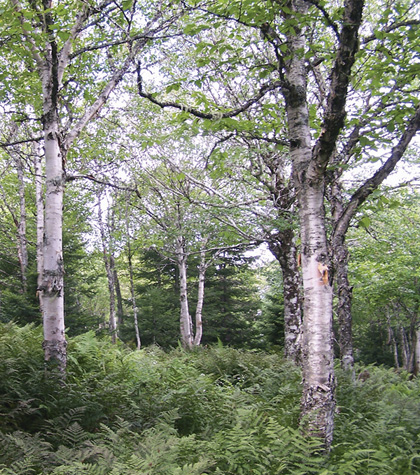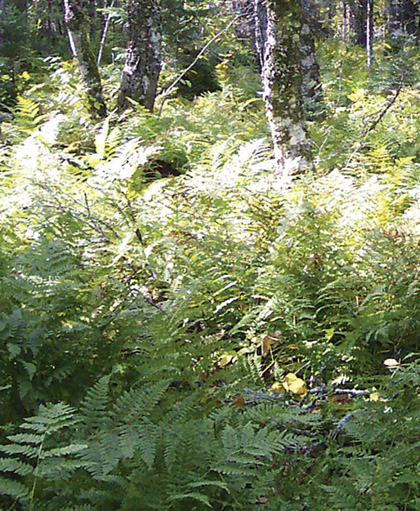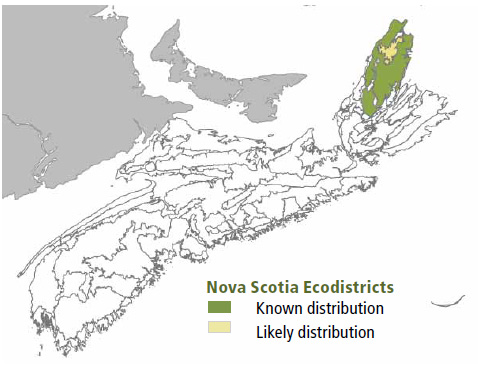
Forest Vegetation types - HL4
HL4 — Birch / Wood fern – Wood sorrel
Betula spp. / Dryopteris spp. – Oxalis acetosella
 |
Cape Clear, Inverness County |
Concept: This mid to late successional Vegetation Type (VT) has an overstory dominated by birch (yellow, white and occasionally heart-leaf) and an extensive herb layer featuring high wood fern cover. Birch / Wood fern – Wood sorrel often co-occurs with HL3 in the transition zone, an informal ecological term used to describe the blended area where Acadian hardwood slopes and the balsam fir plateau meet in the Cape Breton Highlands ecoregion.
Vegetation: One or more birch species are the dominant overstory trees. Common canopy associates include balsam fir, white spruce and red maple – with fir and spruce sometimes occupying small evergreen pockets established after patch-size disturbances. The shrub layer includes regenerating trees, mountain maple, striped maple and mountain-ash. High red raspberry cover may indicate a relatively recent stand-level disturbance. The diverse and well-developed herb layer includes extensive coverage of three wood ferns – eastern spreading, evergreen and spinulose. Sarsaparilla, wood sorrel, wood aster and bunchberry are also commonly found. The bryophyte layer is poorly developed.
Environmental Setting: HL4 is mainly associated with fresh to fresh-moist, nutrient medium to rich soils derived from glacial till and/or colluvium deposits. Richer versions of this VT occur where seepage enhances moisture and nutrient status. HL4 is generally confined to well drained upper slopes within the Cape Breton Highlands ecodistrict, usually at elevations ranging from 250-350 meters. Wind and exposure may significantly limit tree growth. This VT is common in northern New Brunswick and in both the Saguenay and Gaspé regions of Quebec.
Successional Dynamics: HL4 is a mid to late successional VT usually dominated by yellow birch and white birch. Besides harvesting, the main stand-level disturbance agents are windthrow, storm damage and dieback associated with freeze-thaw cycles. An earlier successional stage may include HL2 (White spruce / Wood aster). Depending on disturbance history and the availability of advanced regeneration, transition to HL3 (Yellow birch – Balsam fir / Eastern spreading wood fern – Wood sorrel) is possible. HL4 stands are usually even-aged, but they may show age class breaks, depending on disturbance history.
Ecological Features: Mixtures of white and yellow birch create a mid-successional matrix forest occurring in the transition zone between the Maritime Boreal Cape Breton plateau and adjacent temperate hardwood slopes. Differences in turn-over rates between short-lived white birch and longer-lived yellow birch may result in an uneven-aged stand structure. Yellow birch in this ecosystem can produce stems 17 meters tall with diameters of 75 cm. Large diameter, living, hollow trees are common and provide good denning and cavity nesting sites. They continue to provide valuable wildlife habitat (as large coarse woody debris) after they fall. Yellow birch is an abundant source of seed during the winter for many species of birds and small mammals. Yellow-bellied sapsuckers drill both species of birch, eating the sap and the insects attracted to it. At times ruby-throated hummingbirds may work in partnership, defending the holes from other birds. Vireos may be found in this habitat using small strips of birch bark to construct their nests.
 |
| Fern layer |
Distinguishing Features: Yellow birch, white birch and heart-leaf birch create the overstory of this hardwood forest restricted to the upper slopes of the Cape Breton Highlands ecoregion. Three wood ferns (evergreen, eastern spreading and spinulose) provide extensive coverage.
| Slope Position: | Middle6 Upper4 |
Surface Stoniness: |
(Non - Slightly)6 (Moderately)2 (Very - Excessively)2 |
Bedrock Outcrop: |
(Non-rocky)9 (Slightly - Moderately)1 |
Elevation Range: |
127 - 439m |
Slope Gradient: |
Gentle4 Moderate3 Steep2 nd1 |
Aspect: |
North2 East2 South4 West2 |
Exposure: |
Exposed9 Mod. exposed1 |
Microtopography: |
Moderately5 Slightly4 Level1 |
Drainage: |
Well6 Moderately well4 |
Soil Type: |
ST23 ST32 ST82 ST2-G1 ST2-L1 ST151 |
Parent Material: |
Glacial till7 Till/Bedrock2 Colluvium1 |
Rooting Depth (cm): |
(<30)3 (30-45)4 (>45)3 |
Duff Thickness (cm): |
(6-10)5 (11-20)4 (21-40)1 |

